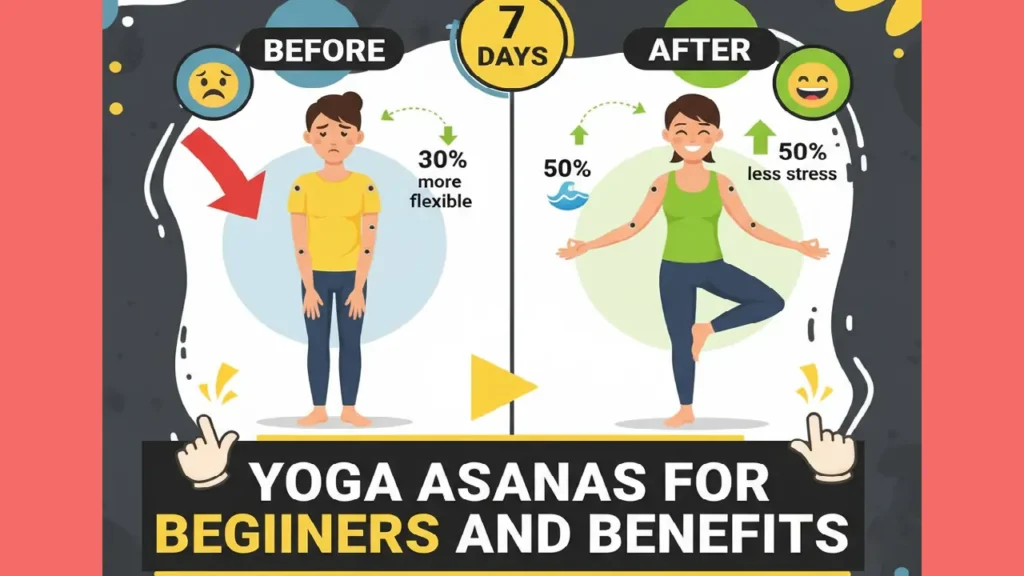Yoga Asanas For Beginners And Benefits

The first time I rolled out a yoga mat I was excited and nervous. My initial thoughts about yoga were that it was the preserve of the hyper-flexible and I soon realized that yoga was a friendly practice to all. The beginner yoga poses are supposed to establish your base at a slow pace and provide a great reward to the mind and the body on the first day.
Studies by Johns Hopkins medicine prove that regular yoga practice can make one stronger, more balanced, flexible, and it is one of the best therapeutic options when it comes to chronic back pain. The best part? It does not require anyone to be a professional to begin to feel good.
Why Start with Yoga? More Than Just Stretching
My first intended aim was to become a little more flexible but the rewards that I received were far much more than this. By making a practice of simple yoga poses, you can experience real changes in your general condition.
My search results indicate a plethora of benefits in accordance with scientific studies and health experts:
Stress Relief and Better sleep: The National Institutes of Health acknowledges yoga as an effective means of dealing with stress. Regular evening yoga practice will help your body and mind to be ready to sleep more deeply and intensively.
Greater Strength and Flexibility: The slow motions and deep breathing enhance the circulation of blood, and poses develop functional strength and flexibility where they are most needed.
Better Mental Health: Mental and physical energy, improved mood, and a reduced number of negative emotions can be due to yoga practice . Research demonstrates that it is effective in alleviating depression, anxiety and stress symptoms.
Improved Body Awareness: Yoga creates a sense of awareness within, and makes you more sensitive to how your body feels. This awareness can also apply to healthier lifestyles, such as healthier eating.
Your Foundation: 10 Yoga Asanas Beginner Workout.
This table describes a balanced initial sequence. Go as slow as your body tells you to go.
Downward Facing Dog (Adho Mukha Svanasana)
Such a common posture in all yoga practices is iconic. it soothes the nerves and is good on your general elasticity.
How to do it: Start on all fours. Bend your toes, raise your hips and straight behind you, into a reversed v. Hold a minimal curl in your knees and work on straightening your spine.
What I would tell you: You should not be afraid that your heels do not touch the ground! And not straight legs, but a flat back.
Warrior II (Virabhadrasana II)
This upright posture gives you the impression that you are strong and firm. It strengthens your back and legs besides making your legs and back stronger.
The way to do it: Spread your feet apart. Rotate your right foot 90 degrees and flex the right knee 90 degrees keeping it over the ankle. Open your arms at right angles with the floor, both with your right fingertips.
My tip: Make sure you do not have a collapsing knee on the front. Your thigh must be at right angles with the mat.
Child’s Pose (Balasana)
This is your reset button. You can always rest in this pose whenever you feel like taking a break during practice. It is so relaxing and decongests muscle tension.
How to: Of all fours, fold forward keeping your hips to the heels and rest your forehead on the mat. Arms may be either straight forward or by your side.
My suggestion: in case your hips are tight, fold a blanket and place it between your sit bones and heels.
Frequently Asked Questions: Beginning Your Yoga Practice.
I’m not flexible at all. Can I still do yoga?
Absolutely! This is the most widespread misunderstanding. Yoga is not a state; it is a process of getting more flexible. Add props such as blocks and straps and change poses when necessary. Flexibility, however, will come as a result of practice.
What is the frequency of practicing yoga as a beginner?
Stability is greater than time. Even 15-20 minutes sessions 2-3 times a week will help you establish a new habit that will become sustainable and produce improvements.
What do I need to start?
You don’t need much! To start with, a yoga mat and comfortable clothes are all you need. Two yoga blocks and a strap may be quite useful in modifications, however, a thick book and a scarf can be used.
I have a bad back/knee injury. Is yoga safe for me?
Yoga is highly therapeutic and it is very important to listen to the body about it and refer to the doctor before hand. This is because you should always communicate to your yoga teacher about any physical limitations or injuries before the class, and the instructor can give you safe alternatives.
